#dead pupa
Explore tagged Tumblr posts
Text
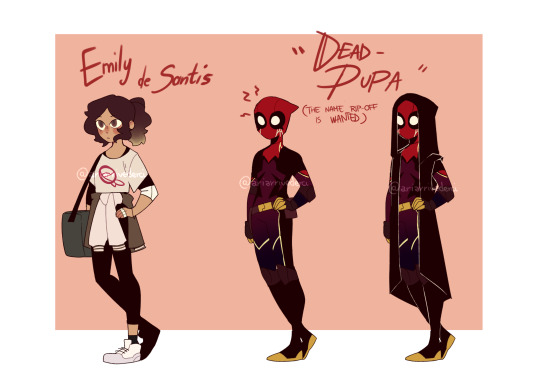

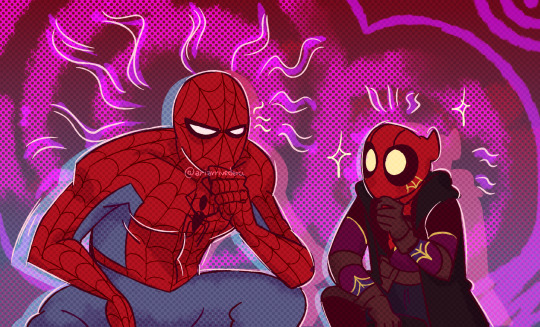
new oc!!! Her name is Emily, but she also goes by her vigilante name, Dead Pupa (the costume in the second pic is the updated one) --- After being bit by a radioactive spider during a biology class, she developes a great agility ,the ability to regenerate her limbs (spiders can do that) and heal very fast The mask she wears is an old thing her brother owned and she wasn't creative enough to create a more unique identity
#spiderman#spiderman fanart#spiderman oc#spider man#spider man fanart#peter parker#peter parker fanart#oc:emily#dead pupa
91 notes
·
View notes
Text

Me and my 250lb larval brother if I’m being honest idfk
#i think its cute when people draw them like kitty sized but in my beautiful mind they are scary huge#not really threatening though unless you are dead or a pupa/freshly eclosed#been thinking about how they’re in the afterlife. thats not good i think. vulnerable people reforming and everything#the babies are hungry and plentiful
10 notes
·
View notes
Text
WAIT WAIT WAIT. this morning i did remembered abt one thing
back then (literally a few months ago and CLEARLY THIS YEAR), during the Early Days™ of the rgverse, i actually had plans to have galactic as the protagonist, and maybe pupa as her companion/support. the thing is, back then, i was planning to make the two of them the EXACT OPPOSITE GENDER AS THEIR CURRENT SELVES.
yea eventually i scrapped that idea, but then i decided to bring them back with the exact opposite gender as their original selves. which is kind of insane now that i think abt it. i. i can't believe i randomly remembered this now. back then, the rgverse was just a fucking shower thought too......
#ohhhhhhh the nostalgia..... (its only a few months ago thesia.)#arthesia's general nonsense#rgverse: misc#where are you? please don't be dead: galactic (oc)#butterflies tear people apart: pupa (oc)
0 notes
Text
Mystery Webs!


I come across these webbed-up fungi occasionally. They look quite like the tent-webs of some moth and sawfly larvae, but differ in occurring later in the year; enclosing a fungus instead of a food-plant; not being full of specks of caterpillar dung; you also rarely see any living (or dead) creatures, eggs or pupae in them.


The cleanness of the webs and the way they are restricted to a particular fungus might make you think you are looking at a grey, fuzzy mould.



To find out what was making these, I took a piece home and kept it in a vivarium. Checking on the vivarium in the middle of the night I spotted a small mealworm-like creature moving through the web, leaving a slime trail behind it. I caught it and put it in an empty enclosure where it soon started fervently weaving by bobbing its head back and forth at an impressive rate, extruding silk from spinnerets on its snout. In the morning, the new enclosure was full of webs, and the larva resting in the middle.


I believe these larvae are fungus gnats of the family Mycetophilidae - a large family of small, rather plain flies with thousands of described species, most of which lay their eggs on fungi. I haven't found much witten about the function of the webs: maintaining a humid atmosphere; excluding other small creatures; catching spores for consumption have all been mooted. The larvae also seem to be able to move smoothly and rapidly through their silk network.

#fungi#mushrooms#Mensularia#Stereum#silk#web#Mycetophilidae#diptera#arthropods#insects#nature photography#argyll#uk
295 notes
·
View notes
Note
Howdy! I recently learned about ambrosia beetles and their specialized structures (mycangia) that hold and transport symbiotic fungi that helps break down wood! What a cool relationship, even if it does wreak havoc on trees across the world. Would you happen to have any pictures of ambrosia beetles/Scolytinae? They tend to be very cute and bullet-shaped and I would love to see more of them!
Ambrosia Beetles:

Granulate Ambrosia Beetle (Xylosandrus crassiusculus), family Curculionidae, SC, USA
photograph by Christina Butler

Gallery, pupae, and an adult beetle of Xylosandrus crassiusculus, one of the most common ambrosia beetle in tropical and subtropical areas worldwide.
image by Hulcr

photo credit: Mary Keim on usda.gov

Ambrosia beetles nurture their gardens of fungus with alcohol
Ethanol in dying trees helps ambrosia fungi flourish
Ambrosia beetles survive by boring into trees and growing fungi inside. They prefer stressed or dying trees, which have more ethanol—an alcohol that's produced naturally by the plant—flowing through their tissues. To find out why, researchers took a closer to look at the black stem borer (pictured), an ambrosia beetle native to Asia that has become a tree-boring pest in North America...
Read more: Ambrosia beetles nurture their gardens of fungus with alcohol | Science | AAAS
FIND OUT MORE:
Ambrosia beetle - Wikipedia
The beetles excavate tunnels in dead or stressed trees into which they introduce fungal gardens, their sole source of nutrition. After landing on a suitable tree, an ambrosia beetle excavates a tunnel in which it releases its fungal symbiont. The fungus penetrates the plant's xylem tissue, extracts nutrients from it, and concentrates the nutrients on and near the surface of the beetle gallery. Ambrosia fungi are typically poor wood degraders, and instead utilize less demanding nutrients. Symbiotic fungi produce and detoxify ethanol, which is an attractant for ambrosia beetles and likely prevents growth of antagonistic pathogens and selects for other beneficial symbionts...
122 notes
·
View notes
Text

[A:4 C:66.2] [Alex] |Jasmine|
“Ploughman Ploughman, Plough me a field. Turn me an acre of laaaaand!” |Thunk goes the shovel and thwup goes the dirt.| “Ploughman Ploughman, Harrow the ground. Drill in the seed and roll it down.”
|Dead garden? Nuh uh!! This garden wasn’t dead n’till you said so!!! You thunk your shovel into the ground and thwup it to the side.| “For the year will turn And the spring come round And the seeeeeed wiiiiiiill grooooooow!”
“What’re you doing?” |You turn around, Bonbon was there! Yay!|
“Hi Bonbon!!” |You smile big and wide and wave at them excitedly.| “‘M working on the garden!!”
“Don’t call me Bonbon!” |They pouted and crossed their arms.| “Only Nille ‘n Bell ‘n stuff get to call me that.”
“Okay!” |You say, undeterred.| “Wanna dig in the dirt?”
|Bonnie looked at you confused, then squinted.| “Maybe. What’s in it for me?”
“Worms!!!” |You say way too excitedly. You drop your shovel and go to your bucket of gardening tools and dig around| “Wanna see me summon a buncha worms at once?!?”
“. . . Why would I want worms?” |Bonnie walks next to you.|
“Worm pie!”
“. . . Worm pie?”
“Worm pie!!!!”
|You get out two sticks, one of them was longer and ribbed.| “Look at! This!!” |You stick the stick deep in the ground, then start rubbing it up and down with the other stick.|
“. . . . . . .”
“. . . . . You look weird-”
“Shh! Shh!!” |You keep it up, and eventually, like magic, worms started poking up from the ground.|
“WOOOOOOOORMS!!!!”
“WOAH!! WORMS!!!”
“What’s this about worms?” |You look over at the house and Nille was coming out the front.| “Woah. That’s a lotta worms.”
“I know right!!!” |You said with sparkles in your eyes.| “It’s so cool!!!”
“Why’d you want so many crabbing worms anyway.” |Bonnie mumbled.|
“Cause all those batty little worms are the beeeest thing for a garden!” |You giggled happily and picked up a few of the worms and spread them across the garden box you were planting in.|
“Huh.” |Nille rubbed her chin, then put a hand on her hip.| “. . . So! What’s your name?”
|You sink down into your shoulders and look down awkwardly.| “Uhm. . . ‘S Jasmine.”
“Well, Jas, mind if I call you Jas? How do ya like the garden box? I saw the old one was broken so I put together a new one for ya.”
“THAT WAS YOU???” |You exclaim, head snapping up, flapping your hands excitedly.| “Oh thankyouthankyouthankyouthankyou!!! It felt really sturdy and nice and mmmmmm!!!”
“Woah careful, I think if I get you any more excited you’ll explode.” |Nille patted you on the back.|
“NO!!!!”
“Yep!” |Nille laughed.| “Ba-boom! And there goes Jazzy!”
“NOOOOOOO!!!!!”
“. . Snrk-gHAHAAHHAAHA!!!” |Bonnie cracked up into a laugh and punched Nille.| “CRABFACE!! You can’t explode like that!!!”
“Language.” |Nille retorted.| “And you totally can-”
“BATFACE!!!”
“Hey!! Language!”
“CRABFACE!!”
“BATFACE!!!”
“CRABFACE!!!!”
“BATFACE!!!!”
“Oh Change you’ve multiplied.” |Nille rubs her temples, but was smiling.| “. . Hey wait, why bats?”
“OH!!!” |You scrunch your face up, thinking.| “. . . Its, uhm, uhm, it’s ‘cause bats eat bugs!! And eat a lotta moths! And moths are important ‘cause of, uhm, uhm. . .”
“‘Cause moths are dreamy’s?” |Bonnie suggests.|
“YEAH!!! Moths are Dreaming and Shining ones messengers!!” |You nod excitedly.| “Start living life asa caterpillar, go into a pupa so you’re not anything, then c’mout asa moth to send messages! ‘N then die, sending messages back to Shining and Dreaming, and then come back!”
“Woooooah!” |Bonnie looked invested.| “Is that why moths are so dumb?”
“Bonbon!!”
“WHAT?!? IT’S A FAIR QUESTION!!!”
“Mhm mhm mhm!!” |You stomp back over to the garden as you talk.| “Lotta moths uhm, get attracted to light!! ‘Cause that’s the fastest way ‘t get back!”
“. . . Oh.” |Bonnie's expression drops. They look away, sad.| “So like ‘Frin.”
“O-oh-” |Nille bites her lip, and kneels down next to Bonnie.|
|There’s an awkward silence for a few seconds. Bonnie crossed their arms and looked away, Nille stood by them, you stood at the garden, awkwardly. You didn’t want to make Bonbon feel bad, you like Bonbon! You like them a lot! Uhm, what do you do when you’re sad. . ?|
“. . . Wanna plant some tubers with me?” |You ask, smiling softly.|
|Bonnie glances at you, then away, pauses, takes a deep breath, and nods.| “Okay.”
|You beamed. Happily digging out a spare set of gloves and trowel for Bonnie as they stomped over and kneeled down. Nille ducked inside for a moment while you and Bonnie got to work.|
|Bonnie stabbed the dirt.| “. . . You can keep singing that song. Or, whatever it was.”
“Huh? Okay!” |You nod, and join in on the stabbing.| “‘S a song about a miller!”
|You smiled big and wide as you cleared away the last of the weeds and dead plants. Nille came back out with two big covered mugs of cocoa for the two of you.|
“Shine the sun and rain the rain, Fall the shivery snooow!! Frost and hail and wind again. As the yeeeear wiiiiiill goooo!!!”
|You feel very happy!|
#THE LEETOL IS HERE#isat#art#in stars and time#isat au#siffrin system au#isat art#sifstem#isat fanart#isat fanfic#isat bonnie#isat nille#isat oc#isat jasmine
32 notes
·
View notes
Text

My meal worm farm setup (for chicken treats). Super easy, takes a few minutes of maintenance in the morning and a slightly more involved one every few months (still only takes a hour).
Has a drawer for pupae, one for beetles, and the rest for various stages of meal worms plus one extra to sift frass (poop) into. Other equipment is a stainless steel colander for sifting and a plastic spoon for transferring pupae and beetles to their new drawers.



I use either bread crumbs or rolled oats for bedding/dry food and carrots or cabbage leaves for moist food. Sometimes they get other stuff, but that's mostly it. Started by ordering a 5000ct pkg by mail and fed out at least half of that while the cycle got started.
The chickens get a "happy hour" on Fridays where they get a half handful of adult worms. They also get all the debris and any dead beetles (crunchy!) when I do the major maintenance.
I keep this setup in what functions as a mudroom for me because it's right next to the kitchen (I do the daily maintenance while waiting for the breakfast skillet to heat) and also so that I don't have to hear them constantly. It's a pretty loud dry rustling/chewing sound--okay periodically but continuously would drive me batty.
In addition to chicken treats, I also get significant amounts of frass:

(Roughly two cups from one sifting)
Frass is an excellent plant fertilizer, like most manures. High in nitrogen. I use it in my soil mixes and sprinkle it into the containers that I grow peppermint in to help with leaf production.
Anyway, was just starting on my big maintenance (which is why there's so many worms in the beetle drawer and very little bedding) and thought I'd share.
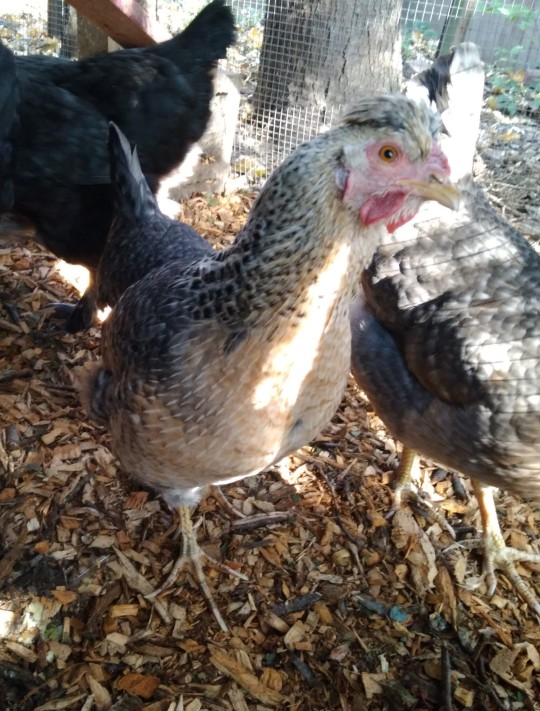
#been going on 10 years now with this set up and haven't added any additional worms#probably should add a cup from the local bait shop or pet store at some point for genetic diversity but eh#mealworms#mealworm farming#small scale#there was a concern a while back about the big bags of dried worms possibly being contaminated with lead and stuff#and the chickens like them live better so#they're fed on scraps so it has zero ongoing cost#which is how we like things here#chickens#chicken treats
28 notes
·
View notes
Text
Queen ant perfumes herself with dead ant.
Here is a Formica Rufa queen who is a parasite of other Formica species (these are the famous wood ants of Europe) She has a dead Formica sp. worker and is gathering hydrocarbons from her exoskeleton to disguise herself as a member of the colony. Then she will likely try to sneak into the nest. Sometimes she will replace the queen, other times simply take some pupae and use them to jumpstart her own colony.
She can open and raise the pupae of many sp. in her genus.
youtube
#ant violence#ant crime#queen ant#wood ants#social parasite#ants#ant posting#formica#ant queen#bugs#antposting#bugblr#insects#antblr#myrmecology#ant#invertebrates#ant hour#Youtube
88 notes
·
View notes
Note
I am a teacher and want to do a unit on bugs for my kindergarteners and preschoolers and I would love to have some live bugs as a class pet.
I would keep the critters after the unit ( I’ve always wanted some and it’s a great excuse to get work to buy it)
Do you have a recommendation on beginner critters that we would be able to observe easily?
I think isopods are a great option since they are harmless, can be colorful, and do well on minimal care! I’ve always thought isopods would be great class pets since they also are good at demonstrating laws of genetics, convergent evolution etc. for older students.
you’d probably do well with Porcellio scaber or Armadillidium vulgare, both hardy temperate species available in a rainbow of color morphs (and often sold in mixed-color cultures). since they eat dead tree leaves, it might be a fun idea to have your kids go outside and gather dead leaves to feed their class pets (make sure it’s away from pesticides). one issue might be that both species are strictly nocturnal and aren’t reliably visible in captivity, spending their time in hiding. you can still flip their hides to find them, but it's best to keep that to a minimum.
if isopods are too mundane, I also suggest cockroaches like dubia or Madagascar hissers. while hissers can climb, dubia can't, and both are harmless and popular insect ambassadors at museums. hissers are good for handling but they still need to be treated gently, and have sharp spines on their legs that they can use to enforce that. if you’re in the southeast esp. Florida these are not legal to keep but I can suggest alternatives.
mealworms and superworms are beetle larvae that eat just about anything and are very hardy to dryness. their complete metamorphosis makes them good teaching species; the superworm Z. atratus avoids pupating in a colony setting so it’s perfect for isolating in little vials so you can watch its transformation into pupa and beetle.
plain old pet store crickets are a very active option too but Acheta domesticus die quickly due to viruses and generally being a crappy bug. if you want crickets find Gryllodes sigillatus—they’re quieter and longer-lived but much more agile
143 notes
·
View notes
Text
Desert folk are nomadic, though during the mating and birthing season most clans come together to settle in riverside towns. These times are always full of creativity and partying, as well as a time of relaxation for most. The desert folk celebrate their collective religion, worshipping the twin suns. They share stories and writing, feast, make clothing, dance, and engage in artistic and hedonistic activities for the duration of mating season. After the season ends, most clans leave the towns to resume their livestock’s feeding rotation, but some clans stay behind in the riverside towns to tend to the buildings and grow crops in the fertile soil.
After the season, work begins once again. The desert folk travel in a rotation unique to each family clan, feeding their livestock on various desert plants. The cow-like animals produce crop milk, hair, hide, and meat. To protect their herds, mature members of a clan carry a rifle. These guns are basic and equivalent to our own blackpowder rifles of the past. They are powerful but relatively inaccurate and slow to reload, so they are used as a last resort or to scare off skittish predators.
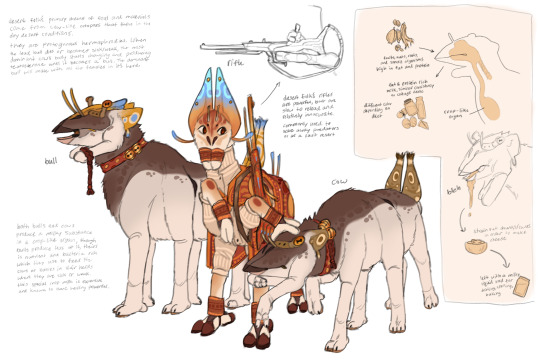
These livestock are the most widely produced due to their hardiness and the variety of materials they produce. Both cows and bulls produce a milky substance using a digestive organ similar to that of Earth’s birds. Bulls produce less of this liquid, but it is more nutrient dense and bacteria dense to help the bull’s cows or calves gain strength or work through a sickness. Bull crop milk is known for having healing properties and the small amounts of it and importance for the herd’s health makes it expensive.
Crop milk is obtained by massaging the crop of a cow or bull until it regurgitates it. It takes practice to feel the crop and figure out if the texture is ready to be consumed. This substance is cottage cheese consistency, and is separated into the curds and liquids. Curds are used to make cheese, while the liquid is used for drinking and cooking.
These animals are protgynous hermaphrodites, meaning that the most dominant cow in the herd’s body will start changing and producing testosterone until she becomes a bull that can take over when the old bull is sick, weak, dead, or otherwise absent. Bulls will protect their cows with ferocity, and mate with each one during mating season.
When a cow gives birth, it is to 5-6 live grub-like pupae that cling to her back and consume crop milk. During this time, many larvae will die until 1-2 are left. When the grubs are ready to pupate, the mother consumes them and stores them in her crop until they are finished pupating, and during this time the cow does not eat. After the babies are finished pupating, the mother regurgitates them, and they can finish growing to their adult forms. She will continue feeding them crop milk until they can eat solid matter on their own.
#saliinthia#salii’qi#desert folk#alien#speculative biology#xenobiology#spec evo#sophont#speculative ecology#speculative evolution#alien cows
188 notes
·
View notes
Text
For the last week or so when I’d wake up there would be like 20-30 flies in my kitchen, made sure all trash and food were disposed of properly, went as far as taping off any seals on doors and windows at night to ensure none could get in. Then I found it- there was a hidden reservoir of dead flies between the wall and the dryer that live flies were laying their eggs inside of. Disgusting creatures. Fly pupae living under the washer and dryer it was so nasty, pulled the washer and dryer out, doused with bleach, crushed, and scrubbed. Every season living in this place has brought a new wave of pests to terrorize me. It’s so old …and porous. Wolf spiders living in the walls, ear wigs, cave crickets, brown recluses everywhere, beetles, never ending mosquitoes. The cats would watch a corner of my living room this summer so I ripped up the carpet and I could see daylight underneath, no floor there! Can’t wait for winter to freeze everything into submission.
21 notes
·
View notes
Text

@crypt1dcorv1dae submitted: Just found this tiny lil friend (only about MAYBE a half inch long) in [removed] (pls remove location), any idea what this little buddy is? And what I should do with them? It's very cold out right now, I don't wanna just shoo the poor lil guy outside into the snow :(
What a cute little dude. It's a cedar longhorn beetle, Semanotus ligneus. Larvae bore in dead, dying, and stressed cedar trees and logs. They pupate in the wood and adults will emerge from the bore hole. It's possible you had some cut cedar in your house they emerged from?
I don't know enough about their life cycle to say whether it's the adults or larvae that over winter - my guess would be the larvae or pupae spend the winter cozy inside their chosen tree or cut/fallen log home.
I don't think there's much you can do for this fella - either let them live their probably brief life inside your home, or find a nice cozy wood pile or something similar to deposit them on outside and hope for the best.
84 notes
·
View notes
Text
✄ lolita
tw: +18, decomposition of the corpse, au, death, mentioned sex character: rindou haitani summary: rindou has several temporary friends left — flies, bacteria, worms, beetles, wasps, larvae, parasites and moths. enjoy your meal.
«hey lolita hey ; shining like a god » ⤷ lana del rey ( lolita )





wolfhart flies — meat flies — buzz loudly over a young but dead body, laying eggs around an open incision in the womb and natural openings: a mouth defiled by someone else's desire, pretending to be "virtuous"; a neat nose, along with dried snot mixed with blood, — saturating sodomistic minds in large clots; eyes that had previously flowed with crocodile tears, barely stretched along with the whimpering of the guy's hellish sore larynx; the virgin ring of the anus, which one of the fake priests could not reach under the «creation of adam» of a dusty but so charming motel; a member standing with a stabbing erection in the morning in this holy cursed place, whose devils conjured with tarot cards and a magic ball taken from the most penniless gypsy without an eye and with a child in her arms; whose hands constantly stroked rindo in dreams, cared for in a way that mothers do not take care of their children. these were the sweetest dreams of his entire stay at the motel, which took him to another «chestnut yard» like a thunderstorm and lightning. during the day, the warm but inanimate corpse makes new friends: the fly larvae hatch in all these places and glide over the organs, dancing, tearing off only a tasty morsel of such sweet, sinfully attractive, shooting a bullet in the forehead just like on that god's day. they cause the miasis of the whole organism, which no longer cares. no one cares anymore.
the body swells from the accumulation of gases in the body, increasing the amount of fluid from cells and blood vessels into the body cavity. bacteria swim rapidly in a bloody pool, breathe frequently (aerobically), multiply, only destroying (and not creating, as was laid down by the creator) tissues and cells, playing the role of savior on the cross, but releasing fluids, — puncturing stigmata.
with hooks in their mouths, young larvae tear apart tissues and spread bacteria, digestive secretion enzymes. they are coming en masse, benefiting from communal heat and the general secretion of digestion. the whole-body fragrance bottle, which includes hydrogen sulfide, methane, cadaverine and putrescine, attracts the girlfriends of meat flies, beetles and mites, which are firmly and firmly absorbed into the flesh, sucking out all remaining inanimate and rotting.
black cream, nauseating and fetid, remains to rot the meat of the whole body, enveloping the whole room with a smell, attracting worms and other insects from underground with a fictional pheromone, rinsed in all the liquid that the soil has absorbed, previously withered arteries.
like a white net, the pupae of parasitic wasps embrace the whole body so gently, to the rhythm of a waltz, twisting into their decadence — which has long since set in like winter snow. eventually, at the fourth stage, the victim is released. several generations of larvae begin to bury themselves underground, wanting to become pupae. flying insects stay away, allowing predatory larvae to get enough.
oil fermentation. the dead man is flat and begins to dry out, the rest of the flesh is eaten, giving off a cheesy smell (not mozzarella with parmesan cheese or even door blue and roquefort next door) caused by butyric acid, attracting more and more gourmet cadaverous organisms. they still can't get enough. almost nothing remains of the body: the meat, or rather its remains, is tough and it is not acceptable for small parasites with their hooks in their mouths to consume it. in their place come predatory beetles, whose eggs hatched during the stage of burying the larvae in the soil. eating away at the previously delicate, silk-like skin, insect paws, with a slight tickle and scabies at the base of the neck, reach the ligaments, tearing them with the chewing cavity of the mouth.
eventually, the hair is eaten by moths and other microorganisms, which in turn feed on ticks. Isn't that lovely!
«beauty doesn't last forever». that's what rindou always thought, while following his daily routine every day: starting with washing his face with professional facial foam and ending with cosmetic masks with lime patches under his eyes, giving the guy always such a fresh look, even if he looked with displeasure at the lustful faces of those who dared to think, guided by the ardent fantasy of elephantida, making him the main a hetaera somewhere in cyprus, surpassing even the greek writer.
ᅠthe dead dance in polka, ᅠit means that it should be so, ᅠif the coffin does not hold you back, ᅠlet's dance till we drop. ᅠhave your muscles rotted along with your skin? ᅠthis is not a hindrance to us! ᅠlet 's break our bones all the same, ᅠfor fun and for laughter! ᅠwho have you been to — what's the deal? ᅠthieves, beggars, poets, ᅠif death sang a song
ᅠᅠthe skeletons will dance their own dance.
when the boy cries — large tears drip onto the open wound of his red knees, salt seeps into the very depths — which makes alcohol better and more pleasant, — and it stings, corrodes, does not allow calm breathing, leading to hysteria of hidden souls buried somewhere deep inside. inviolability and purity, the beauty of age, tenderness and such genuine love, angelic, given by god and taken away by him on the day of judgment — god's judgment at the sight of satan, soon flying like a bullet into lilith's maternal arms.

#r1mmvhub ⚝#tokrev#tokyo revengers#tokyo revengers fandom#tokyo revengers fanfiction#tokyo revengers smut#tokrev rindou#tr rindou#tokyo revengers rindou#rindou haitani
7 notes
·
View notes
Text




dump
#(art)hesia#arthesias ocs#where are you? please don't be dead: galactic (oc)#the one who got away: spinel (oc)#the math expert himself: aleph 0 (oc)#butterflies tear people apart: pupa (oc)#what an agonizingly long journey it has been: abstruse (oc)#the embodiment of chaos and destruction herself: arghena (oc)#original character#original characters#oc#ocs#oc art#art#digital art#rgverse: artwork
0 notes
Text
WASP REVIEW - BEEDRILL (POKÉMON)

[Image ID: The official artwork for Beedrill, a Pokémon from the first generation of the Pokémon franchise /End ID.]
Now, if you're just stumbling upon this post you may be a bit confused or up in arms here. "Beedrill clearly isn't a wasp, it's a bee!", and that's an entirely fair assessment, it's in the name afterall! However, as returning readers may recall from last week, while they are generally described separately in conversation, from an entirely taxonomical perspective, bees are wasps themselves, having evolved from predatory wasps and being a sister lineage to the wasp family ammoplanidae.
Furthermore, in my opinion, with the seemingly slick surface layer of its presumably chitinous exoskeleton, Beedrill closer resembles a paper wasp rather than the more expected honey bee, having little to no setae/fur to speak of (most if not all wasps, including paper wasps, do have setae themselves, but only in a few families of wasps, such as Mutillidae or the bee families, are these easily visible to the naked eye).
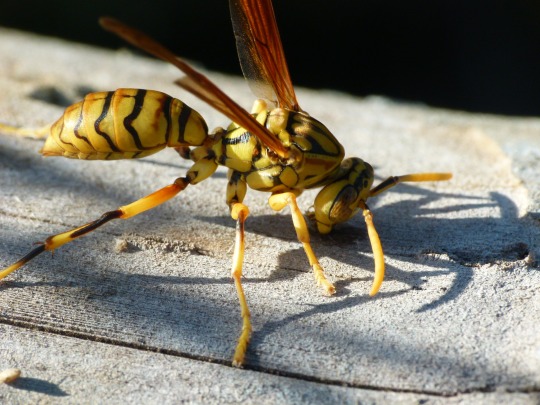
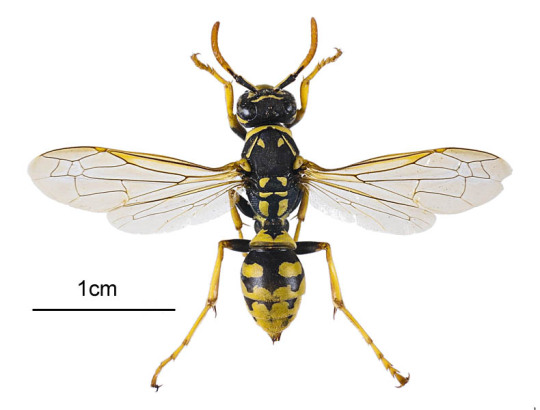
[Image Source: Wikimedia Commons, L. Shyamal and CABI Digital Library, Muséum De Toulouse | Image IDs: A photo of the yellow, black, and brown paper wasp species Polistes olivaceus collecting wood to form its nest, followed by a photo of another, similarly colored species, Polistes dominula, with its wings outstretched /End IDs.]
This idea is strengthened by the Pokédex entry from Pokémon Crystal, which states that Beedrills will hunt down prey to bring it back to the nest, a behavior similar to that of Vespid wasps, only somewhat paralleled in eusocial bees by Vulture Bees, three species in the genus Trigona (But even then, they don't hunt prey down, they collect flesh from already dead carcasses, hence the comparison to vultures).
That, however, brings us to a very important question, that being, they bring it back to the nest for what, exactly? I can only assume that this is a type of food store for the fully evolved adult Beedrills, something that is not actually true at all for the real world Vespids. Many adult wasps are incapable of feeding on solid matter without it being liquified, so the paper wasps (as well as yellowjackets and hornets) carry their prey back to the nest to feed those of them that can actually eat it, their larvae.
This is where the Beedrill line gets particularly unusual and interesting. As you might recall if you know anything about Gen 1 of Pokémon, Beedrill evolves from Kakuna, which, in turn, evolves from Weedle.


[Image IDs: The official artwork for Weedle and Kakuna, two Pokémon from the first generation of the Pokémon franchise /End IDs.]
While the cells of a wasp nest are typically used to house the larvae, larvae of Beedrills, the Pokémon Weedle, are free roaming creatures, only becoming eusocial in the final stage of evolution, often found among plants, feeding on leaves (Not on the meat). Although Beedrills still appear rather defensive of their young, they can move around entirely on their own! This may be another thing that confuses Pokémon fans that are unfamiliar with Hymenoptera, as the free roaming and leaf eating form of Weedle sounds an awful lot like a caterpillar, especially with the addition of the tree hanging cocoon Pokémon, Kakuna. However, this perfectly aligns with some of the Hymenopteran ancestors of the modern day wasps, sawflies!


[Image Sources: ResearchGate sources One and Two, Bao-Zhen Hua | Image IDs: A collage of photos displaying multiple instances of the larva of the Sawfly species Arge pagana feeding on leaves, followed by another displaying the same species as prepupae on the top and pupae on the bottom /End IDs.]
Even in Kakuna sometimes being known to attach itself to trees using silk or a silk like material is true of sawflies, with many Hymenopterans (including the aforementioned sawflies, paper wasps, and honey bees) being capable of producing this material in their larval stage to create cocoons or reinforce their nest cells during their subsequent pupation.
As you might realize, as well, both Weedle and Kakuna, as well as Beedrills, regardless of sex, possess stingers (not visible in Kakuna, but stated in multiple Pokédex entries including Yellow, Gold, and Let's Go, although contradicted in Red/Blue and X/Y), this is untrue of sawflies in general as well as any young wasps or male wasps. The stinger is a modified ovipositor, a reproductive organ, and is specific to the suborder Apocrita.
I'm going to have to let this slide, among other things, though, as these three Pokémon are clearly, like all Pokémon, are highly fantastical in nature and not necessarily going for realism. I mean, Beedrills are not only missing a middle pair of legs but also have an extra two stingers on the end of their forelimbs (four, on both pairs, in the case of Mega Beedrill)!
It is also implied in a few instances that Beedrills produce honey, which is not only the case in the most famous honey producing insects, the honey bees, but is a trait that is surprisingly also found, to varying degrees, in some Vespid wasps, notably including Brachygastra mellifica and Polistes annularis!
All in all, Beedrill has fascinating inspiration/real world equivalents and a cool design, but can also be confusing in a few ways to entomologically analyze.
-
Overall: 6/10
-
This wasp was suggested by @shadybug , leave your wasp review suggestion in the replies, tags, or askbox!
23 notes
·
View notes
Text
If you are curious about how the Day of the Dead is celebrated in Italy, read here!
You may find similarities with your own customs 💕💕
A small excerpt: As is typical of Italy, the food for the festival varies from region to region. In Toscana and Milan the “pane dei morti” is said to be the characteristic offering. It may be made with hazelnuts and grapes. In northern Puglia, a wheat growing region, a sweet dish for the Day of the Dead is Colva or “Grains of the Dead”. It is made of softened and cooked wheat grains, pomegranate seeds, crushed nuts, vincotto, chocolate and sugar. Fave dei morti or “fava beans of the dead” are not beans at all but rather small cookies made with almond meal, and are another dish for the day found widespread through Italy. Ossa dei morti, suitably elongated and frosted “bones of the dead” are sweets found in Puglia and Sicily. Sicily also boasts sweets: “martorana” which look like fruit, and “pupa” small figurines (again sweets). Children participating in such celebrations are likely to be spoilt for choice. In the video linked below, we see a table loaded with food of an even greater variety and can meet the Signora Maria mentioned above, as well as observing some of the “dress up” and rituals the day involves.
#crimson talk#halloween#samhain#day of the dead#dias de los muertos#wheel of the year#day of the dead in Italy#Italy#Italian culture#Italian traditions
57 notes
·
View notes